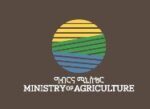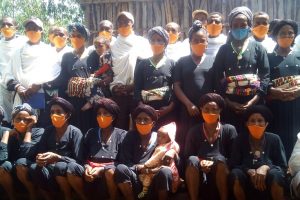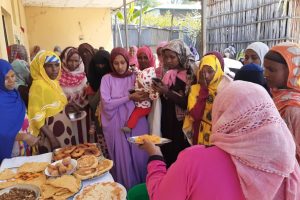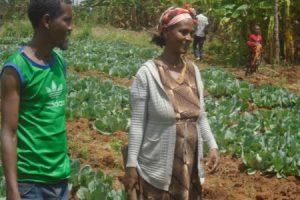
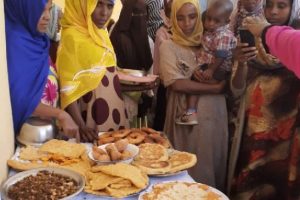
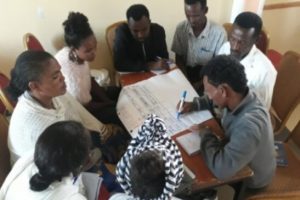
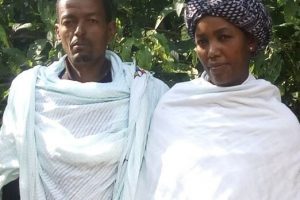
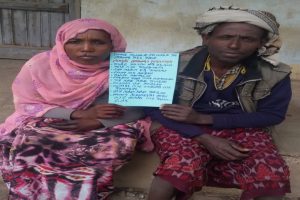

Gender and Nutrition
PASIDP-II in its program has dedicated to bring equitable benefit & participation of women with their counter part and it is also striving to secure food & nutrition in the program implementation areas by implementing different activities.
Gender Mainstreaming
In PASIDP II intervention areas women specifically would be helped to: (i) access irrigation schemes; (ii) enhance their skills in irrigated farming, with particular reference to production of high value crops; (iii) enhance women’s representation on IWUAs, FRGs and cooperatives, and strengthening of their leadership capacity; (iv) access financial support through MFIs and RuSACCOs; (v) FRGs and extension groups for women; (vi) access labor-saving technologies, (vii) nutrition-sensitive agriculture and home gardens for women. In addition, the gender approach will be based on: (a) quotas if required, at least 40 % of women among beneficiaries of the various activities; (b) Transformative Household Methodologies to ensure women participation and to enhance gender equality; (c) monitoring of women participation in activities; (d) gender training for program implementers.
Targeting is achieved through a range of communally accepted criteria geared to encourage active participation of more vulnerable groups in the decision making processes. To realize this targeting the program has identified 3 key activities to be achieved: one is ensuring 50% Women participation on trainings, 2nd ensuring at least 30% of women participation in farmers’ organizations committee membership of such as Irrigation Water Users Associations (IWUA), Irrigation Inputs & Marketing cooperatives (IIPMCs) Watershed management committees and others; and the 3rd is at least 20% women in FHHs and 30% women in MHHs benefited from program interventions (technology) demonstrations.
The concept of GMF is conceived in the idea that “life has to change completely.” Gender relations of power and control are changed when men and women become models for gender equality, recognizing that men and women should enjoy the same Rights and Opportunities. A GMF approach is made up of a husband, wife and their children who want to be models for Change and Transformation in Society by challenging traditional notions of gender roles and responsibilities. Having a number of GMFs in a given community transforms that community. That is, as we create more GMF beneficiaries, more women and men start to question some of the reasons for their relationships and actions, and decide to bring about changes.
Read More
The most important approach which can help extension workers reach females in male headed households is community awareness creation & consultation on gender mainstreaming via GMF. Thus, the program has started to strengthen the implementation of GMF demonstration in 13 schemes on 650 households in this fiscal year. The second round of GMF demonstration training for beneficiaries is now underway, with the goal of scaling out to other potential neighbors and colleagues. So, 690 HHs have been identified and consulted thus far, and the second phase of training has been conducted. As the Gender Model Family approach has been implemented in the Amhara region at three schemes since 2019, Gedeb 4 SSIP GMF beneficiaries who have made significant changes in their households and villages have been recognized and graduated, as well as experience sharing among the program regions (Oromia, Sidama, and SNNP) and the hosting region woredas. The gender model family (GMF) approach reached 524 pioneers and 1087 extended households for a total of 1602 households across the program regions.
Success Stories
The implementation of gender model family approach has registered meaningful changes in the relations and livelihood of households. Reports from field supervision and support sessions both at federal and regional level observations depicted; the significant changes observed are listed below.
- Local culture prevented women from accompanying their husbands to the farm field, after the GMF approach intervention, this has changed, and women have begun to accompany their husbands and assist with seeding, hoeing, weeding, and other tasks. (Welmel Tika),
- Previously, children regarded fathers as strangers who came and went, and mothers suffered from the strain of carrying children on their backs and fronts while performing household duties, but now that men have begun to care for children, children’s love has returned to fathers, alleviating the work burden on wives;
- A family told us that after GMF, they conferred with one another and agreed to send their children to school by sharing home responsibilities and saving money.
- When a wife married, she had more than ten cattle inherited from her parents, which her husband sold without consulting her and spent all of the money on drinks and bad habits, but now everything has changed, he has stopped drinking, and the household consult with his wife in any expenditure and saving, as a result their livelihoods has changed. (Kelate) and
- Husbands planned to share all domestic responsibilities, such as cooking wot, preparing coffee, baking bread/ingera, and others.
Nutrition Sensitive Agriculture
The program has put in place initiatives to support nutrition sensitive agriculture to increase production of fruits, vegetables, pulses and cereals, which is expected to be accomplished through: Promoting production of improved fruit and vegetable varieties at household and community level, supporting establishment of fruit and vegetable nurseries and demonstration gardens/sites at model farmer fields and FTCs and promoting intercropping and mixed farming technologies and practices.
As per the PASIDP-II implementation plan, Nutrition sensitive agriculture lies within Component B. The objective here is to maximize the positive impact of the food systems on nutrition outcomes while minimizing any unintended negative consequences of agricultural policies and interventions to the target population. The focus is to have year-round availability, access and consumption of diverse, safe and nutritious foods of plant and animal source.
